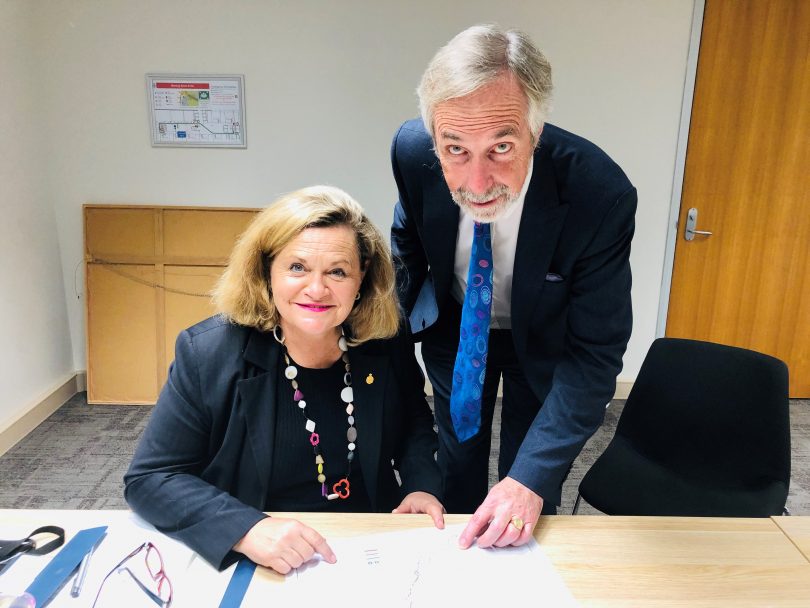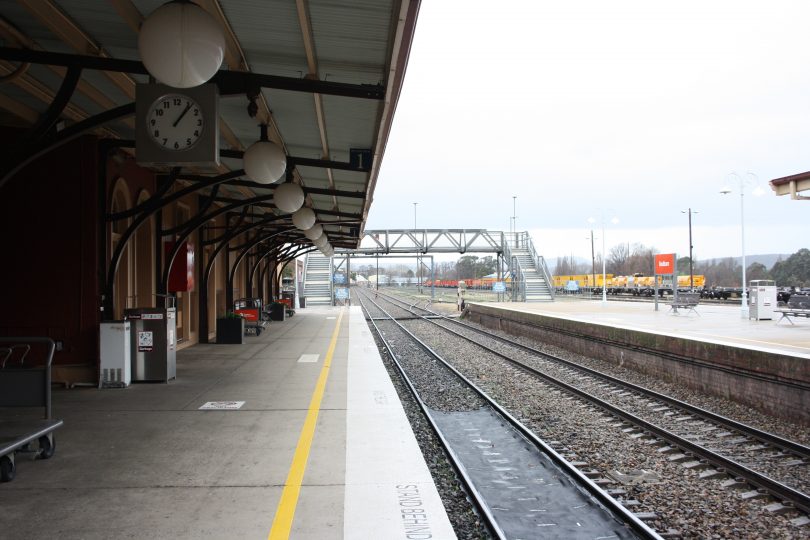
Local Member for Goulburn Wendy Tuckerman met with Professor Andrew McNaughton recently. Profesor McNaughton chairs the NSW Government’s expert panel and is overseeing the development of a Fast Rail Strategy for NSW. Photos: Supplied.
Transport infrastructure and rail times in the Goulburn region were key issues in the closely fought battle for the seat of Goulburn in March, and with the NSW Government’s Fast Rail Strategy expected to be delivered before the end of 2019, all eyes are on what it might contain for the ACT and Goulburn region.
The Southern Corridor, which includes Canberra and Goulburn, has been identified by the government as among rail routes for investigation into a NSW fast rail network with a prediction that delivery of fast rail has the potential to slash travel times by up to 75 per cent. However, it’s unlikely this region will see substantial improvement in travel times in the shorter term.
While the NSW Government has committed $295 million over four years to begin early works on the fast rail network, money going to new rail alignment is primarily being spent in the outer Sydney regions on the north and south coasts, planning a route to the Central West, and to preliminary work on a new straightened track to high speed standard between Menangle in the Macarthur region and Yerrinbool in the Southern Highlands.
While it could be argued that major centres like Goulburn on the Southern Corridor would benefit from time savings on a faster journey from Menangle to Yerrinbool, the four-year funding cycle means that unless additional funding is announced, passengers can only anticipate ‘incremental’ improvement in travel times.
Member for Goulburn Wendy Tuckerman recently met with the chair of the expert panel developing the strategy, Professor Andrew McNaughton, an international fast rail expert advising the government on the delivery of a fast rail network. Professor McNaughton has also been meeting with organisations, agencies and councils in the region.
“I welcomed the opportunity to meet with Professor McNaughton to share my views on the benefits fast rail would deliver for local job growth, business activity and community access to services and social opportunities,” Mrs Tuckerman said.
“The NSW Government looks forward to receiving the Fast Rail Strategy … and is committed to identifying immediate improvements to existing corridors that deliver incremental benefits to customers, while building towards a fast rail network that delivers transformational journey times.”
Experts agree on the economic benefits to communities located along fast rail corridors and, equally, regional rail lobby groups agree on the need for faster train services.
Charles Sturt University Associate Professor Ian Gray, whose research has focused on the link between rail services, regional development, and social issues, believes a train service that is attractive to commuters can make a big difference to communities’ access to employment, health and other services. Smaller towns and villages along the line can also benefit, as well as larger population centres.

A key election issue, towns like Goulburn on the Southern Corridor will be eagerly awaiting recommendations on train station locations for future fast rail service.
Mrs Tuckerman acknowledges large-scale transport infrastructure projects take time.
“International experience shows that fast rail projects are complex and aren’t delivered overnight. It requires a bold vision for improved connectivity that clearly articulates where and when fast rail investments should be made to maximize benefits for communities,” Mrs Tuckerman said.
Despite the complexity of delivering a fast rail infrastructure, the NSW Government’s Fast Rail Strategy is to be welcomed, providing it is implemented over successive funding cycles and potential government changes. To date, limited progress has been achieved on high-speed rail in Australia.
“Professor McNaughton will identify the preferred alignment of the rail line, recommended train speeds and station locations. This work will also inform potential improvements to existing rail corridors in the short to medium term,” Mrs Tuckerman said.
The NSW Government is also replacing its aging regional rail fleet of XPT, XPLORER and Endeavour trains. The new trains will improve safety, accessibility, amenities and reliability for commuters travelling from Sydney to the regions, as well as Canberra, Melbourne, and Brisbane.
Planning and detailed design work have already begun for the new fleet with the first of the new trains expected to be running from 2023.
In the meantime, towns and larger regional centres along the Southern Corridor are anticipating what the Fast Rail Strategy might say about possible locations for train stations and how they might eventually benefit from faster rail times.
And local MPs in regions across NSW, some in marginal seats, will continue to face commuter and regional development pressure for fast rail services.
You can find out more about the NSW Government’s Fast Rail Strategy here.
Original Article published by Maryann Weston on The RiotACT.







